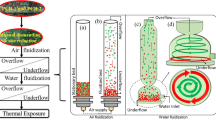Abstract
The pollution caused by the spent printed circuit boards (PCBs) is currently a concern of researchers and environmental managers due to its large quantity and exceptionally complex properties. This study characterized printed circuit boards (PCBs) from discarded computers using a number of characterization techniques , including chemical analysis, X-ray diffraction (XRD), Fourier transform infrared spectroscopy (FTIR), granulometric analysis and scanning electron microscopy (SEM). The PCBs contain approximately 50 wt% metals, 25 wt% glass fibers and 25 wt% polymers. The principal metals include copper , calcium, tin , aluminum, zinc and lead. They are still wrapped by brominated epoxy resin after the PCBs are preliminarily crushed. As precious metals, such as gold and silver, are barely found in the PCBs, copper and tin are the main metallic elements of recycling value which warrants extra attention.
Similar content being viewed by others
References
Estrada-Ruiz RH, Flores-Campos R, Gamez-Altamirano HA, Velarde-Sanchez EJ (2016) Separation of the metallic and non-metallic fraction from printed circuit boards employing green technology. J Hazard Mater 311:91–99
Yamane LH, Moraes VT, Espinosa DCR, Alberto J, Tenrio S (2011) Recycling of WEEE: characterization of spent printed circuit boards from mobile phones and computers. Waste Manage Res 31:2553–2558
Jha MK, Kumari A, Choubey PK, Lee J, Kumar V, Jeong J (2012) Leaching of lead from solder material of waste printed circuit boards (PCBs). Hydrometallurgy 121–124:28–34
Bizzo WA, Figueiredo RA, de Andrade VF (2014) Characterization of printed circuit boards for metal and energy recovery after milling and mechanical separation. Materials 7:4555–4566
Xu Y, Liu J (2015) Recent developments and perspective of the spent waste printed circuit boards. Waste Manage Res 33:392–400
Ogunniyi IO, Vermaak MKG, Groot DR (2009) Chemical composition and liberation characterization of printed circuit board comminution fines for beneficiation investigations. Waste Manage Res 29:2140–2146
Kim B, Lee J, Seo S, Park Y, Sohn H (2004) a process for extracting precious metals from spent printed boards and automobile catalysts. JOM 56:55–58
Veit HM, Diehl TR, Salami AP, Rodrigues JS, Bernardes AM, Tenrio JAS (2005) Utilization of magnetic and electrostatic separation in the recycling of printed circuit boards scrap. Waste Manage Res 25:67–74
Evangelopoulos P, Kantarelis E, Yang W (2015) Investigation of the thermal decomposition of printed circuit boards (PCBs) via thermogravimetric analysis (TGA) and analytical pyrolysis (Py–GC/MS). J Anal Appl Pyrol 115:337–343
Das A, Vidyadhar A, Mehrotra SP (2009) A novel flow sheet for the recovery of metal values from waste printed circuit boards. Resour Conserv Recycl 53:464–469
Veglio F, Quaresima R, Fornari P, Ubaldini S (2003) Recovery of valuable metals from electronic and galvanic industrial wastes by leaching and electrowinning. Waste Manage Res 23:245–252
Zhang Y, Liu S, Xie H (2012) Current status on leaching precious metals from waste printed circuit boards. Procedia Environ Sci 16:560–568
Fujita T, Ono H, Dodbiba G (2014) Evaluation of a recycling process for printed circuit board by physical separation and heat treatment. Waste Manage Res 34:1264–1273
Oliveira PC, Cabral M, Nogueira CA, Margarido F (2010) Printed circuit boards recycling: characterization of granulometric fractions from shredding process. Mater Sci Forum 636–637:1434–1439
Peng Z, Hwang JY (2015) Microwave-assisted metallurgy. Int Mater Rev 60:30–63
Guo X, Qin FGF, Yang X, Jiang R (2014) Study on low-temperature pyrolysis of large-size printed circuit boards. J Anal Appl Pyrol 105:151–156
Wu W, Qiu K (2015) Vacuum co-pyrolysis of Chinese fir sawdust and waste printed circuit boards. part II: influence of heating conditions. J Anal Appl Pyrol 111:216–223
Acknowledgements
This work was supported by the Science and Technology Major Project of Gansu Province, China under Grant 1602FKDC007, the National Undergraduate Training Program for Innovation and Entrepreneurship under Grant 201510533213, the Shenghua Lieying Program of Central South University under Grant 502035001, and the Innovation-Driven Program of Central South University under Grant 2016CXS021.
Author information
Authors and Affiliations
Corresponding author
Editor information
Editors and Affiliations
Rights and permissions
Copyright information
© 2017 The Minerals, Metals & Materials Society
About this paper
Cite this paper
Peng, Z. et al. (2017). Characterization of Spent Printed Circuit Boards from Computers. In: Ikhmayies, S., et al. Characterization of Minerals, Metals, and Materials 2017. The Minerals, Metals & Materials Series. Springer, Cham. https://doi.org/10.1007/978-3-319-51382-9_55
Download citation
DOI: https://doi.org/10.1007/978-3-319-51382-9_55
Published:
Publisher Name: Springer, Cham
Print ISBN: 978-3-319-51381-2
Online ISBN: 978-3-319-51382-9
eBook Packages: Chemistry and Materials ScienceChemistry and Material Science (R0)




